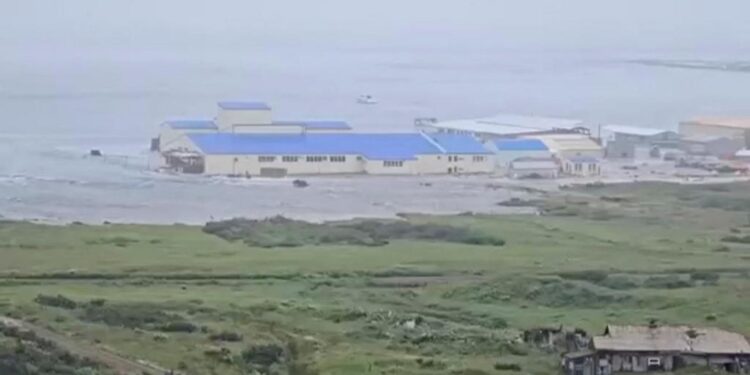A powerful undersea earthquake struck off the east-southeast coast of Russia’s Kamchatka Peninsula on July 30, triggering tsunami waves and prompting mass evacuations across the Pacific region.
The quake, registering a magnitude of 8.7 to 8.8, was one of the strongest recorded in the area since 1952 and occurred at a shallow depth of about 19 kilometers beneath the seafloor. The epicenter was located approximately 125 kilometers southeast of the city of Petropavlovsk-Kamchatsky.
The earthquake immediately set off widespread tsunami warnings and watches, including for the Russian Kuril Islands, Japan, Hawaii, Alaska, the US West Coast, Canada, and several nations across the Pacific Basin, such as Mexico, Peru, Ecuador, New Zealand, and Australia.
In Russia, waves reaching between 3 and 5 meters flooded parts of Severo-Kurilsk, leading to the evacuation of over 300 residents. Buildings, including a kindergarten, suffered structural damage, and although some injuries were reported, authorities confirmed there were no fatalities.
Japan responded swiftly, ordering the evacuation of nearly 2 million people in coastal prefectures from Hokkaido down to Wakayama. Authorities anticipated tsunami waves up to three meters high and issued alerts to all residents in low-lying areas, urging them to seek higher ground. Meanwhile, Hawaii declared a state of emergency and implemented coastal evacuation protocols as waves around one meter in height reached multiple islands, including Oahu, Maui, Hilo, Kahului, Nawiliwili, and Pearl Harbor. The tsunami sirens activated across the islands stirred anxiety, with some residents saying they had never heard them go off in over a decade.
Tsunami watches were also issued for Alaska, Guam, and Micronesia, where authorities remained on alert, monitoring wave activity and advising residents to stay clear of coastlines. Along the US West Coast and parts of British Columbia in Canada, advisories warned of smaller waves and possible strong currents, though no significant damage or injuries were reported. Ports in Los Angeles and other major cities were temporarily closed as a precaution.
The Pacific Tsunami Warning Center and regional agencies credited the rapid alerts and coordinated emergency responses for minimizing casualties and larger-scale destruction. While tsunami waves were observed across vast swaths of the Pacific, the impact remained relatively contained, highlighting the effectiveness of modern seismic and oceanic warning systems.
Authorities in Russia and Japan continue to monitor the region closely as aftershocks—some reaching magnitudes as high as 7.5—have rattled the Kamchatka area. Seismologists warn that more seismic activity is likely in the days ahead. Officials across affected regions have urged residents to remain cautious, avoid returning to coastal areas prematurely, and follow instructions from emergency services.
As the Pacific braces for potential further geological shifts, the disaster stands as a reminder of the volatile tectonic forces shaping the region and the importance of preparedness and global coordination in the face of natural catastrophes.
Header image: The BBC














